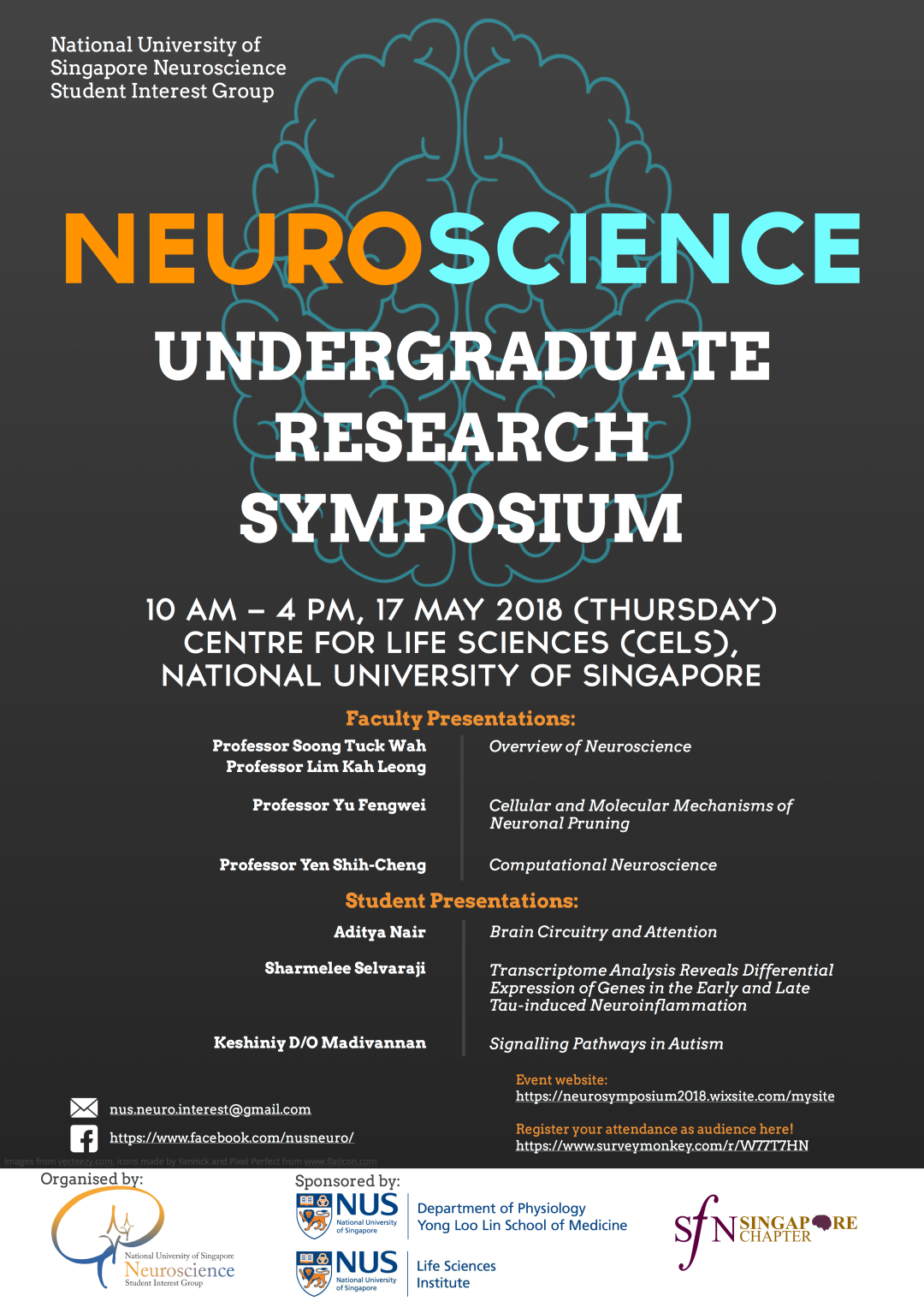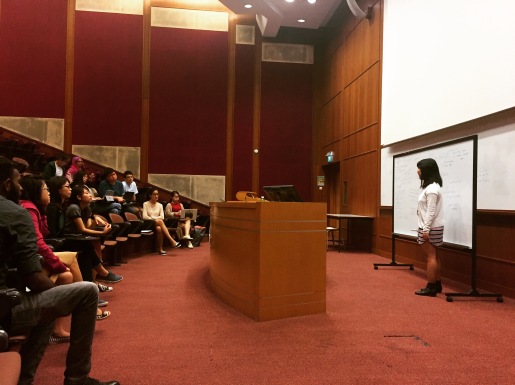Written by Sasinthiran
Edited by Xin Chen, Yingchen and Keshiniy
On the 29th of January 2016, the NUS Neuroscience Student Interest Group conducted its first seminar titled ‘Neurons, Glia and Neurophysiology’, hosted by Sasinthiran (Year 3, Life Sciences).
Participants were provided reading material on the topic compiled from various sources two weeks prior to the seminar. At the start of the seminar, participants attempted to complete a quiz (18 questions) in groups of 3-4 members within 30 minutes.
![_20160209_181639 [2344380].JPG](https://nusneurointerest.files.wordpress.com/2016/02/20160209_181639-2344380.jpg?w=441&h=576)
The quiz questions were then discussed in an interactive format whereby groups had to defend and justify their answers if they differed from that of other groups.
The discussion started off with a question on the permeability of the blood-brain barrier (BBB). It was first highlighted that the components of the BBB are the tight junctions between the capillary endothelial cells, the basal lamina of the capillary and the perivascular foot processes of astrocytes (a type of glial support cell). It was noted that water and water soluble agents were able to diffuse across via the tight junctions while charged species such as sodium ions were first transported by trans-membrane protein pumps/ channels into the endothelial cells of the blood capillaries and subsequently into the brain. Lipid soluble molecules are free to diffuse through the phospholipid bi-layer of the endothelial cell membranes while larger charged molecules such as glucose ( primary energy source of the brain) and amino acids are transported by by trans-membrane transport proteins. Other solutes may also be transported by receptor-mediated endocytosis when they bind to their specific receptors on the surface of the endothelial membrane, as well as adsorptive transcytosis. It was noted that due to tight junctions between the capillary endothelial cells, leukocytes a(white blood cells) and other immune cells may not be able to cross the BBB to a great extent and hence the brain relies on a local population of cells known as the microglia (not derived from neuroectodermal lineage but from immune cell lineage) which mediate local immune function (e.g. phagocytosis and secretion of inflammatory factors such as interleukins to attract other immune cells).
Next, the discussion focused on the profile of an action potential (AP). It was noted that the refractory period (decrease in membrane potential to a value more negative than the resting membrane potential) after the peak in voltage of an AP had two parts: the absolute refractory period (lasting 1 msec due to the closing of the inactivation gate of sodium ion channels) during which no action potential can be generated followed by the relative refractory period during which a higher than usual stimulus is required to depolarize the membrane to threshold potential in order to trigger an action potential. It was also noted that the fall in membrane potential below that of resting potential because the voltage-gated potassium channels that opened at the peak of the AP were slow to close and hence allowed more potassium ions to diffuse out of the neuron, down its concentration gradient.
The discussion then looked at the factors affecting the speed of conduction along an axon and 4 factors were identified: higher temperature, wider diameter of the axon, increased myelination (insulation) and decreased length (between nodes of ranvier) all favor faster conduction. It was also noted that different classes of axons with different diameter and myelination properties exist in the body to serve their particular functions. for example, when someone hits his toes against a hard surface, the faster A-delta fibres that are myelinated conduct a sharp pain sensation while the slower unmyelinated C fibres conduct the slow, dull pain that follows.
Next, we reviewed the various gating mechanisms of ion channels: ligand-gated, mechanosensitive (e.g. stretch-activated), voltage-gated, photon-gated (responds to light) or even ungated. We briefly discussed the recent development of optogenetics in which genes coding for a light-sensitive receptor has been transferred and expressed in select populations of mice neurons to modulate their behavior when that region is exposed to light via an optic fiber cable.
Our discussion then moved on to define the terms that describe a cell membrane’s potential. Depolarisation represents a rise in membrane potential from a negative resting potential towards the potential of 0mV (same internal potential as outside of the cell). Repolarisation represents a drop in membrane potential from 0mV to a more negative potential. Hyperpolarisation refers to a drop in membrane potential to a value more negative than that of the resting potential.
Next, we had a brief review of the activity at the neuromusccular junction (NMJ) that results in the contraction of skeletal muscle fibres for movement. It was noted taht acetylcholine was the primary neurotransmitter released at the NMJ.
The discussion then moved on to briefly touch on the fact that groups of axonal tracts that run up and down the spinal cord are arranged in columns. It was noted that such tracts are called projections when observed in the brain.
We then proceeded to discuss the factors responsible for the establishment and maintenance of the action potential: the unequal distribution of ions inside and outside the neurons (sodium, chloride and calcium ions are concentrated outside the cell while the inside of the cell has a higher concentration of potassium ions and other large non-difussible anions that also contribute to the negative resting membrane potential), the action of the sodium-potassium ATPase pump which pumps out 3 sodium ions and pumps in 2 potassium ions against their concentration gradient (thereby resulting in the net loss of one positive ion) as well as the free diffusion (leakage) of potassium ions out of the cell through leaky potassium channels.
Next, the discussion focused on the role of glia in the nervous system. It was noted that there has been a paradigm shift from considering glia simply as cells that form the matrix that hold the neuron together to one that accepts their active role in the nervous system. For example, astrocytes have been found to form a ‘tripartite synapse’ with post- and pre-synaptic neurons and even modulate and synchronize their communication through the release of gliotransmitters (visualised trhough the observation of signature calcium waves in the astrocytes which lead to the fusion of vesicles containing gliotransmitters to the astrocyte membrane to release the gliotransmitters). Microglia have the potential to differentiate into astrocytes or neurons, modulate local immune response through phagocytosis and release of cytokines such as interleukins to attract other immune cells (inflammation) as well as guide young neurons during neuronal migration in early development. Schwann cells (in the PNS) and oligodendrocytes (in the CNS) form myelin sheaths around axons to nourish the cells and at the same time speed up the conduction of action potentials. It was noted that the key difference between neurons and glia is that glia do not generate action potentials. It was noted, however, that a population of the pacemaker cells in the sinoatrial (SA) and atrioventricular (AV) nodes of the heart are the only other cells outside of the nervous system that are capable of generating their own action potentials.
The next question revisited the profile of the action potential and it was noted that the rapid depolarisation of the membrane was due to the rapid influx of sodium ions through their voltage-gated channels (more open upon membrane potential reaching threshold potential), driven by both their electrical and chemical gradients into the neuron.
Next, we looked at the summation of input from pre-synaptic neurons in a post-synaptic neuron that could either lead to to an EPSP (excitatory post-synaptic potential) or an IPSP (inhibitory post-synaptic potential). It was noted that if the excitatory effect is greater than the inhibitory effect but less than the threshold of stimulation, the result is a subthreshold EPSP. Furtehrmore, if the excitatory effect is greater than the inhibitory effect and reaches or surpasses the threshold level of stimulation, the result is a threshold or suprathreshold EPSP and one or more nerve impulses. Alternatively, if the inhibitory effect is greater than the excitatory effect, the membrane hyperpolarizes, resulting in inhibition of the postsynaptic neuron and the inability of the neuron to generate a nerve impulse.
Subsequently, we went on to review the fact that stimuli intensity is encoded in the frequency of action potentials which are of equal magnitude (amplitude). The higher the stimuli intensity, the higher the frequency of the action potential.
We also identified that the falling of the membrane potential towards resting membrane potential was due to the opening of voltage-gated potassium channels at the peak of the action potential, leading to an efflux of potassium ions out of the cell, down its concentration gradient. As noted before, the slow closure of these channels results in the drop in membrane potential past that of the resting membrane potential (refractory period).
Next, we briefly discussed the experiment conducted by German physiologist Otto Loewi which proved that neurons communicated through chemical messengers that we now know to be neurotransmitters. He stimulated one frog’s heart, collected fluid around it, transferred it to another frog’s heart, and saw change in its heart rate.
We then moved on to briefly discuss a thought experiment and concluded that if we wanted to cause the pre-synaptic terminal of an axon to release its neurotransmitter without an action potential, we could inject calcium into its pre-synaptic terminal. This is because of the fact that the influx of calcium into the pre-synaptic terminal (usually when an action potential reaches the pre-synaptic terminal and depolarise the membrane, causing the opening of voltage-gated calcium ion channels) results in teh fusion of synaptic vesicles containing neurotransmitters to the pre-synaptic membrane.
Next, we discussed the differences between metabotropic and ionotropic receptors. Ionotropic receptors have a pore which opens/ closes to directly control the passage of ions while metabotropic receptors when activated, trigger an intra-cellular signalling cascade to cause an ion channel to open/ close in response (indirect control of movement of ions). Thus ionotropic receptors have fast acting effects and and its action is short-lived while metabotropic receptors have slower effects that last longer (due to signal amplification in the signalling cascade).
The seminar concluded with the discussion of the learned concepts in more challenging application questions. Firstly, we discussed the scenario whereby an action potentaial is triggered at same time from both directions of an axon (in both the orthodromic and antidromic directions). In this case, we concluded that when both action potentials meet at a point along the axon, they will not propagate any further. This is because the region just behind the each action potential is undergoing a 1 msec absolute refractory period in which no action potential can be generated since the voltage -gated sodium ion channels have their inactivation gates closed for that period.. Thus both the orthodromic and antidormic action potentials cannot proceed ahead in their direction of propagation.
There was also a short sharing on the role of GABA as an excitatory neurotransmitter in the neurons of fetuses (due to the high intracellular chloride ion concentration). The role of Glutamate as both an excitatory and inhibitory neurotransmitter in the retina was also discussed and it was noted that the effect of neurotransmitters is dependent on the type of receptor it binds to (metabotropic or ionotropic).
The quiz questions, answers and further information on the topics discussed can be found here: Neurons Glia and Neurophysiology.





![_20160209_181639 [2344380].JPG](https://nusneurointerest.files.wordpress.com/2016/02/20160209_181639-2344380.jpg?w=441&h=576)
